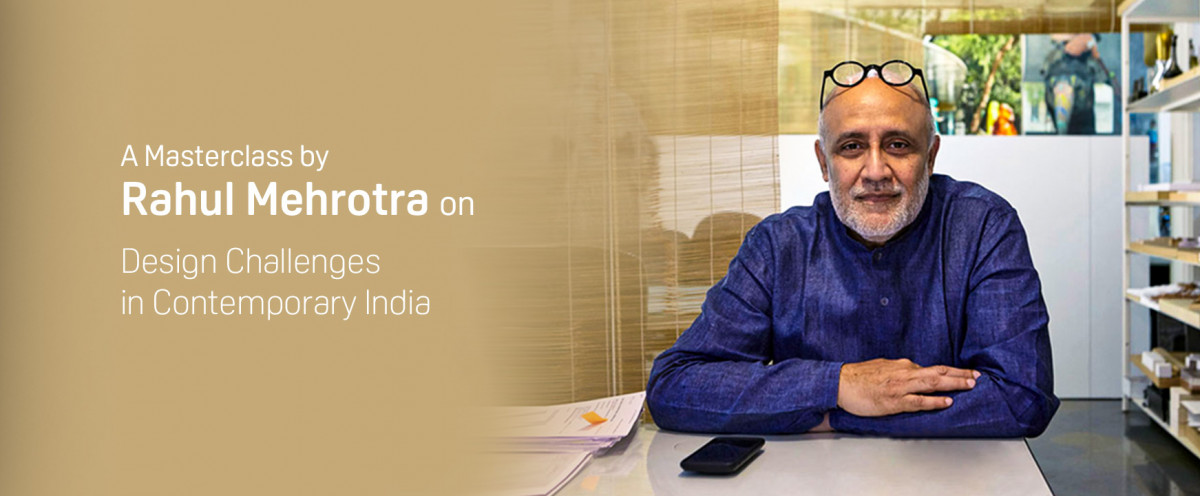
5:30PM
And we are all set! Mr. Rahul Mehrotra has taken the stage! Here we go..
5:50PM
This talk is my reflection on India. My experiences and perspective. And how architects and as citizens we can contribute to the world.
5:51PM
The context with which we build becomes absolutely important in today's times
5:54PM
Besides the disruption that globalisation has caused, capitalism is valid for many reasons but not at the cost of environment.
5:56PM
A lot of the discussion on sustainable architecture is around - spatial articulation and the human dimension.
5:59PM
Context is often narrowed down and made site or territory specific. What one needs is to see what the context behind context.
6:03PM
Space becomes elastic in cities. A cricket ground in a city becomes a space where other events take place too. That is what a Kinetic City is.
6:05PM
What is a kinetic city? A city that is a twitching organism and is defined by the 5 stages of squatting.
In this city, space becomes elastic, appropriated and re-appropriated
The formal and the informal city coexist. Architecture is not even a spectacle of this kinetic city.
6:06PM
Brittle forms driven by vendors, software that twists and turns buildings -
These form the landscape of 'impatient capital'.
6:09PM
3 criteria of Urban India as declared by Government.
1) Population over 5000
2) Density of 400 persons/sq km
3) Over 75% of the male population in non-agriculture employment.
6:12PM
The important question Architects must ask is 'Are we making Permanent solutions to Temporary problems?'
6:14PM
We are stuck with Absolute solution. The aesthetics make us do absolute solutions. We need to counter that.
6:16PM
Kumbh Mela takes the idea of absolute flux to another limit, challenging our notion. During every Kumbh Mela, it emerges as a city that transitions into a case study on ephemeral urbanism.
6:19PM
Architects, if you can create instruments of advocacy, it might not pay your bills but it will lead to a long term solutions.
6:21PM
An architect has 3 clients - Patrons, Operational and User.
6:23PM
Change the mainstream. If you change the mainstream, we can bring phenomenal transformation in our country!
6:43PM
Creating empathy helps in creating better buildings and structures. The lowest paid workers and the highest paid workers have to co-exist in your workplace/projects.
6:46PM
Social dimension is important in your work space. Your space must encourage intersection of people promoting social interaction and vibrancy.
6:49PM
Taking global programs and localising them to suit your architectural needs is important.
6:52PM
Sanitation is a huge problem in our country. Toilet to people ratio is really bad. 48% of India’s urban population has no access to toilets. But things will change soon, we have to think about transitions.
6:55PM
The community toilets needs to be taken seriously. That’s where the transition for transformation will take place.
6:56PM
Transitions some time take you in directions which make you think you have moved away from the issue... but its more important how you make your way back to it.
6:57PM
Failures are accumulated knowledge. Use them as instruments for advocacy.
6:59PM
We have to be prepared for failures, failures help you to make improved decisions. As an architect you should be ready to embrace failures.
7:17PM
Don’t take what the client says for granted. Adding context to the client’s brief is the value you provide as an architect.
7:18PM
Rahul Mehrotra ends his masterclass by calling for more empathy in how we build - making mistakes and trying again is the nature of building empathy, as it is the nature of good architecture.
7:20PM
On Design Thinking Rahul Mehrotra says -
Design Thinking is the ability to resolve conflicting forces and aspirations. Whatever we design comes with challenges, it’s your ability to aesthetically resolve it.
7:25PM
Question: Building and architecture are part of the culture, when you propose transitionary solutions, won’t it affect our culture?
Rahul Mehrotra: In architecture, the ephemeral is part of our culture. Culture is the implicit rules of a society. It is ever transforming. Every generation makes its own culture.
7:30PM
Question: How to solve the issue of water while building toilets.
Rahul Mehrotra: Historically water has been the element that sanitation has been imagined. There has to be a technological shift. Solution for sanitation will come when that technological shift is imagined.
7:34PM
Question: How should we go about making Smart Cities?
Rahul Mehrotra: The answer is to make smart agents. Facilitating people, making people smart is the solution. We need to think of more humane solutions while building cities. The issue with designs today is that we are focused on putting the objects before the DNA. Before smart cities, we need to pause and renew our cities.
7:39PM
Rahul Mehrotra's advice to budding architects -
Don't be fooled by the blinkered eye approach. Move out to smaller towns and become agents of change. Look outside the big cities, we need to focus on small towns.
8:00PM
That's it from us today. Hope you enjoyed this masterclass by Rahul Mehrotra today. Stay tuned for many such events in the future. Thank you for joining us.